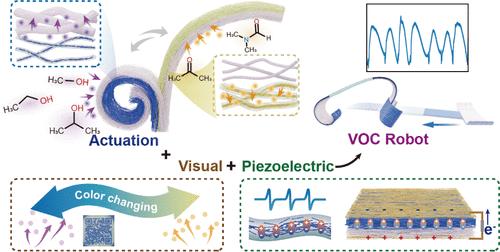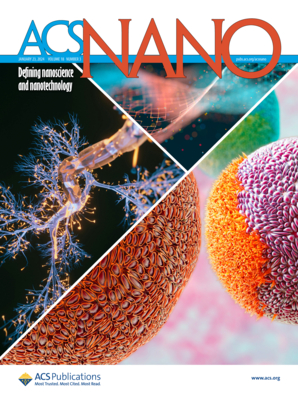All-Fiber Volatile Organics-Perceptive Actuators
IF 15.8
1区 材料科学
Q1 CHEMISTRY, MULTIDISCIPLINARY
引用次数: 0
Abstract
Soft robots with real-time volatile organic compound (VOC) perceptivity are promising for dynamic hazard detection. However, reconciling VOC-responsive actuation with an autonomous perception remains challenging. Inspired by Victoria amazonica, which blooms and closes with synchronous color change under environmental stimulations, we developed a solvatophore-induced solvatochromic-piezoelectric material by synthesizing a solvatochromic molecule-modified palygorskite-enhanced polyvinylidene difluoride and realized a VOC-responsive all-fiber actuator with solvatochromic and piezoelectric properties for cooperative visual and electrical perception of volatile organics. Under VOCs, the actuator exhibits bidirectional bending, obvious and stable color change, and characteristic piezoelectric output, allowing the identification of the type and concentration of the VOC. The solvatochromic-piezoelectric actuator demonstrates a large bending curvature of 4.63 cm–1, an ultrafast response speed of up to 4.36 cm–1 s–1, and excellent stability of 1500 actuation cycles without fatigue, with synchronous VOC-induced piezoelectric output reflecting actuation conditions. VOC-responsive solvatochromic and piezoelectric sensing, manipulation, and robots were demonstrated as applications. The VOC-triggered soft robot demonstrates stable motion with synchronous piezoelectric output, capable of autonomously perceiving and responding to environmental VOC. This work presents a widely applicable interactive visual-electronic VOC detection strategy for safety, health, and environmental protection, which could also inspire the exploitation of high-performance responsive fiber materials.

求助全文
约1分钟内获得全文
求助全文
来源期刊

ACS Nano
工程技术-材料科学:综合
CiteScore
26.00
自引率
4.10%
发文量
1627
审稿时长
1.7 months
期刊介绍:
ACS Nano, published monthly, serves as an international forum for comprehensive articles on nanoscience and nanotechnology research at the intersections of chemistry, biology, materials science, physics, and engineering. The journal fosters communication among scientists in these communities, facilitating collaboration, new research opportunities, and advancements through discoveries. ACS Nano covers synthesis, assembly, characterization, theory, and simulation of nanostructures, nanobiotechnology, nanofabrication, methods and tools for nanoscience and nanotechnology, and self- and directed-assembly. Alongside original research articles, it offers thorough reviews, perspectives on cutting-edge research, and discussions envisioning the future of nanoscience and nanotechnology.
 求助内容:
求助内容: 应助结果提醒方式:
应助结果提醒方式:


